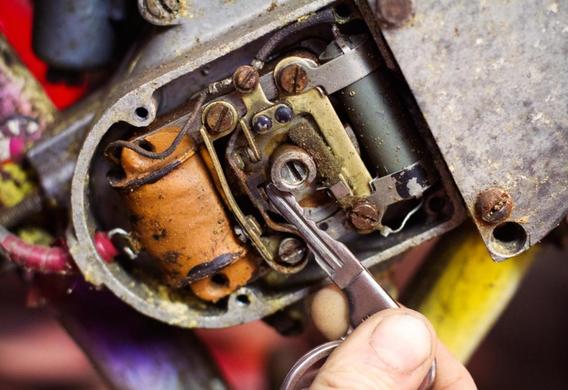
The name "contact-ignition" recalls the mechanical switching of the high voltage current on the spark plugs. In this, in our days of the almost forgotten system, the supply of voltage to the primary coil of the coil-ignition and the shutdown of the voltage is carried out by the contacts within the ignition control body. Contact Ignition History
Contact Ignition History
The first capable battery system contact was developed by Charles Kettering from Delco (continuing to deliver electronic components to this day). The system was installed on the Cadillac of 1910 and excited the motorists.
In diesel engines, the contact-ignition system has never been used
In our time, the contact-ignition system has given its place to a simple and reliable miscontact with microprocessor control. In our country, the contact-ignition system has been used much longer than in Europe, the US or Japan. The contact ignition was installed on "classic" VAZ vehicles until around 2000.
Components of the contact ignition system
To ensure that a mixture of fuel with air is flammable in the combustion chamber, it must be sealed. In petrol engines, the role of the ignition is performed by the spark plugs, which at the dawn of automobiles, by the way, were called dirty. For the high voltage current to the candle and inflame the fuel, it is necessary, first, to be generated, and secondly, to be transferred.
Owners of "classic" VAZ cars with contact on their own set the electronic ignition sets from VAZ 2108
A power supply is required for the generation of a high voltage current. Two-generator and battery are present in the source vehicle, and both produce a low voltage of 12 Volts. This is not enough to ignites the mixture, and the LV voltage is fed to the ignition coil, that is, the transformer. Since there is no permanent "switch", a mechanical high voltage distributor, combined with a low-voltage power-supply circuit breaker, should not be permanently present in the system since the voltage is increased. The mechanical allocator is composed of a rotor (the "thumb") and the lid of the allocator. The cover has center and side contacts mounted. With these elements, the high voltage current from the ignition coil shall be transmitted to all candles.
Working principle of the contact ignition
When the circuit breaker is closed, that is, when the key is turned in the ignition switch, the low-voltage currents start the initial winding of the coil. When you turn on the starter and start the engine, the high voltage distributor, combined with a low voltage power-supply circuit, starts to operate. The laisers are given to the gears fortified at the crankshaft. At the time of the start, the crankshaft starts to spin by driving the mechanism of the allocator. Inside the allocator at this point, the contact points for the transmission of the voltage to the cylinder will be alternately flushing and blurring. When the contact is cleared, high voltage live currents that flow through the central high voltage wire from the coil to the lid of the balancer are formed in the secondary coils of the coil. At the moment of closure of the next contact the voltage shall be introduced to the corresponding candle and the fuel-air mixture ignites.
In the more advanced contactless ignition system, the mechanical circuit breaker has been replaced by Hall sensor
After an outburst in one of the cylinders, the circuit breaker is blurred by a low voltage circuit, turning off the reel for a short period of time. High stress on the secondary coil is maintained. To prevent jumps from power off and to protect the mechanical contacts of the valve cap and the burnout voltage in the allocator, a capacitor accumulating current and giving it back in the moment when the circuit is open.
Role of the centrifugal regulator in the contact-ignition system
The centrifugal regulator, which is also inside the valve body, changes the spark timing in accordance with the engine crankshaft revolutions, from which the ignition engine is driven. For complete combustion, the flash shall be small a given advance, that is, before piston at the top inside the cylinder. The correction of the advance angle is necessary to avoid harmful phenomena for the engine-detonation, potash ignition and diesel.
Features of the contact-ignition
The first and main advantage of the contact-ignition system is its simplicity. A small number of components and a clear, even distant one from an electro-electro-man, the principle of work gives him a chance in an emergency to repair the ignition with his forces, even in the field.
The "Oka" car was fitted with an original spark-ignition system with a mechanical allocator
But the points of contact are weak. As the mechanical parts of the operation are worn out, the stability of the candle, which is sparks, is worsening. In addition, the mechanical contact group is not the optimal device for high turnover.
As with all mechanisms with working elements, the contact-ignition system is first of all aligned with the components. The most distressed part of the contact-ignition is the breaker of the flycatter. The fact is that the upper part of the valve governor has several gravel (the quantity is equal to the number of cylinders). The wounds of the rubble, they "run" to the cudgel, the crowing spring-loaded contact, and the blurring of it. It is not surprising that a small cunet is quickly washed away. When you have problems with the contact-ignition, start the diagnostics from the contact line.







